MasaleBhat simply means spice infused rice. It is a delicacy in Maharashtra, my home state, and a must for festivals, weddings and special occasions. As the name suggests, it is warm and spicy and does pack a punch.
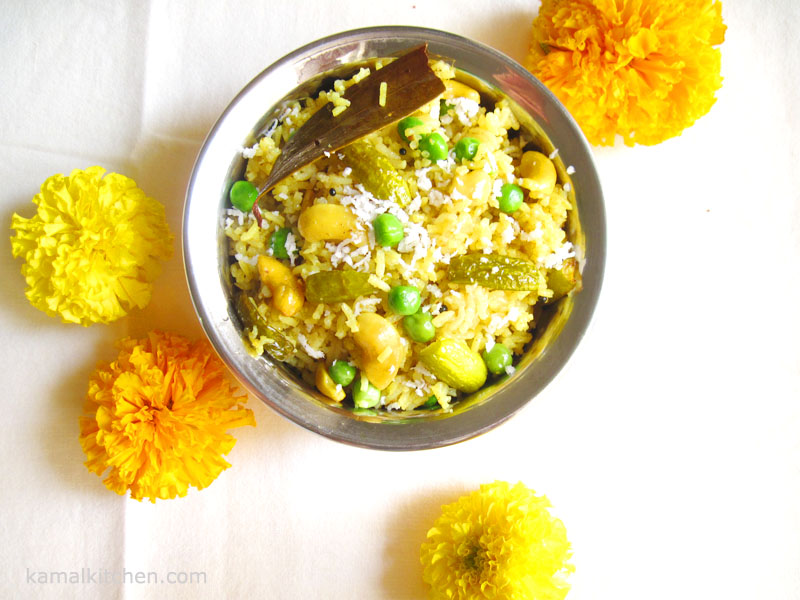
In our culture, there is a traditional way of serving a meal. Although we don’t follow this process now, it is nice to come across it sometimes at weddings, christenings etc. and other such events. Yes, sometimes, because even wedding meals have given in to the changing times and become Punjabi Buffets. As a child, I simply loved attending weddings, especially because of the ‘pangat’, or the traditional seating arrangement for the meal and the abundant dishes.
There were wooden stools which were wide and just a few inches tall. There used to be two rows of these. One was used to sit on, and the other was used to keep your plate, often a large banana leaf or a plate made by sewing together dried leaves. These were of course disposable and bio degradable.

There would be a procession of servers, each one in charge of one item. First there would be a flurry of people who would serve food which was placed on the left side of the plate – salt, lemon wedge, pickle, chutney, and fried papad or vadas. Then there would be 2-3 bowls for the daal, the buttermilk or mattha, and maybe for the green vegetable or pattal bhaji.
Next would be a line of people serving up food for the right side of the plate. This would include dry vegetable dishes and usals or legumes. Then came the white rice which was topped with plain daal or sadha varan and a dollop of ghee. And then, the Masale Bhat was served next to it.

The meal started with a prayer, and then the white rice and plain daal was consumed first. Masale Bhat or spiced rice came next. After offering seconds – people had hearty appetites in those days – chapattis or rotis and puris would be offered. Sweets like Jalebi and Laddu would be added right in, to be eaten along with the meal, and sometimes there were other sweets like Gulab Jamun or Shrikhand served in bowls.
After consuming multiple rounds of Rotis and Pooris with the various veggie dishes, the servers brought in the rice again. The meal was washed down with mattha, a thin version of buttermilk spiced with ginger and herbs.
Oh well, can you tell I am either very hungry or very nostalgic?
So, this is how favored and important the MasaleBhat is in Marathi cuisine or the cuisine of Maharashtra, my native state.
A couple of years ago, I came across a readymade spice mix called ‘Masalebhat Masala’ made by Bedekars (brand). It is simply too awesome, but it is not readily available. Even here in Pune, I need to drive an hour to find a store that stocks it. So, if you can get your hands on it, fine.
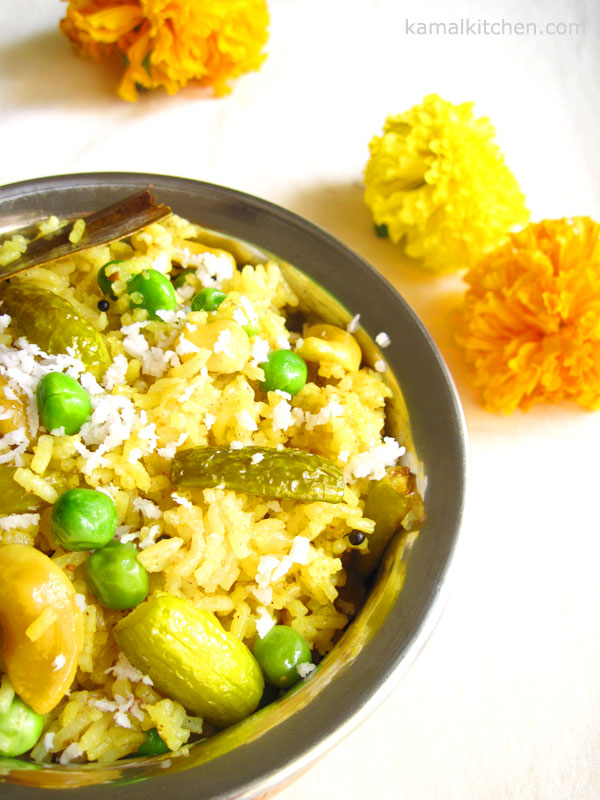
If not, I have a fantastic recipe for you. As usual, it is from scratch but also very simple.
There are some veggies which are traditionally added to the MasaleBhat. Tindora or ivy gourd/ Coccinia is preferred. Green peas are a must. You can add cauliflower or potato too, but they add their own peculiar taste.
Brahmin cooking does not generally use onion or garlic, especially for festivals, weddings etc. So this MasaleBhat is a no onion, no garlic recipe.
Ghee is favored and gives a heady aroma to the rice, but you can just use vegetable oil instead. Simply omit the ghee to make this dish vegan.
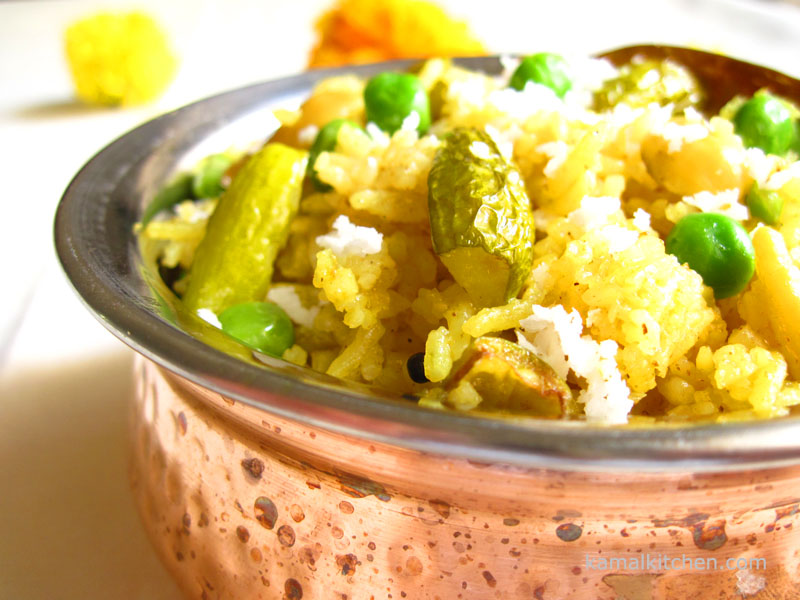
Small things make a big difference in taste. So for really fresh flavors, go the extra mile and pound up some fresh roasted coriander seeds instead of using the coriander powder that has been languishing in a jar in your pantry. It literally tastes like dust!
For the rice – use any long grain rice like Basmati or Kolam. It will work well.
With Diwali coming up, we have many traditional meals in the offing. So I hope you try this MasaleBhat and use it for your Diwali table.
MasaleBhat Recipe
Ingredients
- 2 cups rice uncooked
- 1 cup ivy gourd sliced
- 1 cup green peas
- 2 Tbsp ginger grated
- 1 tsp green chili paste (optional)
- ½ tsp cayenne pepper
- 2 Tbsp coriander ground
- 1 tsp garam masala
- 1-2 bay leaf
- 2 Tbsp oil
- 2 Tbsp ghee (optional)
- 2 Tbsp cashews pieces
- 1 tsp sugar
- Salt to taste
- 1 tsp black mustard seeds
- ¼ tsp hing or Asafetida
- 1 tsp turmeric ground
- Chopped Cilantro or coriander
- Fresh grated coconut
- More ghee
Method
- Cut the ends off the gourd and slice vertically in half. Cut once more to get quarters.
- Wash the rice and drain.
- Heat oil and ghee in a pressure cooker/ pressure pan or in a stock pot.
- When oil smokes, add the mustard, hing and turmeric for a basic tadka. Add the bay leaf.
- Immediately add the gourd and fry for 2-3 minutes.
- Add the cashews and the rice and toast well. Add half the spices at this time.
- Add 4 cups water and stir well.
- Now add in the grated ginger, remaining spices and the green peas.
- Season with salt and sugar.
- At this point, you can just put the cooker lid on and pressure cook for two quick whistles. Alternately, you can bring it to a boil and then simmer with a covered lid until the rice is cooked.
- You can also transfer this whole mixture to an electric rice cooker, shut the lid and let it cook.
- Ideally, the rice should be fluffy but well cooked.
- Serve topped with fresh coriander or cilantro, grated coconut and more ghee, with a squeeze of lemon.
- Note: This makes enough for 4-5 people as part of a large meal. Or it can be a one dish meal for 3 people easily.
Have you ever tried making MasaleBhat? Don’t you think this is pretty simple to try? Please do leave a comment and let me know how when you do.
If you liked this rice recipe, be sure to check out my book RICE BOWL!
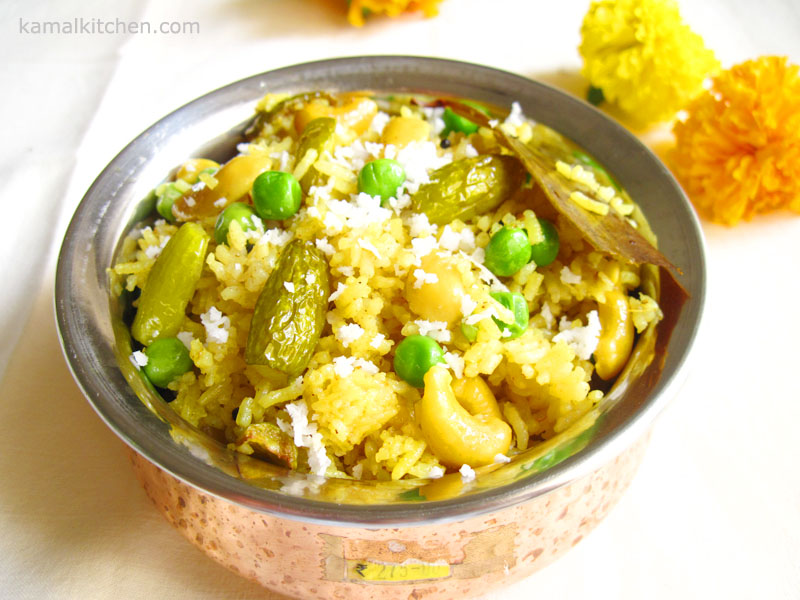
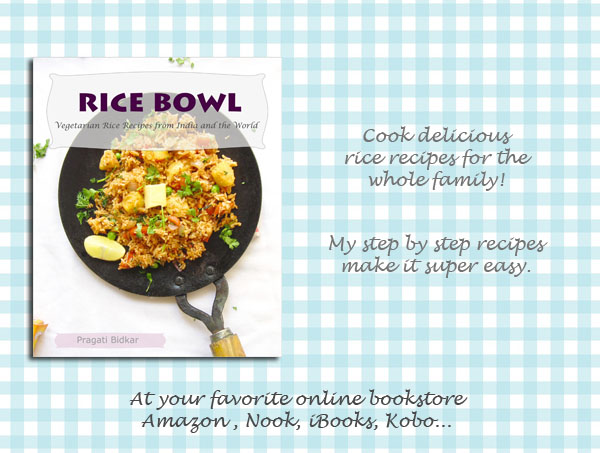
Hi Pragati! Your MasaleBhat looks lovely and delicious, so colorful too, and sounds perfect as part of a celebratory meal!
Hey Peggy, How are you?
Thanks much..yeah…this is a must have item at the holiday table in my family 🙂
Hi! Pragati.,
It is nice to read that you are from Pune – I am also from Pune and live in the USA for the past 31 years. I still cook Indian Food and also a lot of Maharashtrian dishes like the Rajma which is our favorite especially my granddaughter who is 6 years old. My grandson loves Palak Paneer and of course we love our dal and every day I cook Moong or Masoor and at times I made Tur. We also love to make Rasam which as you know is a South Indian Dishes. So please send me some easy to make vegetarian meals. Take care – Gloria
Wow…that’s a long time..love Napier road..
Great dish and easy to make, I like it there are no garlic and onion on it(:
Thanks Andapo…traditionally, many of our dishes don’t have onion, garlic..it is a more recent influence.